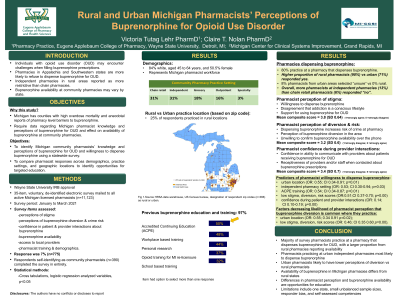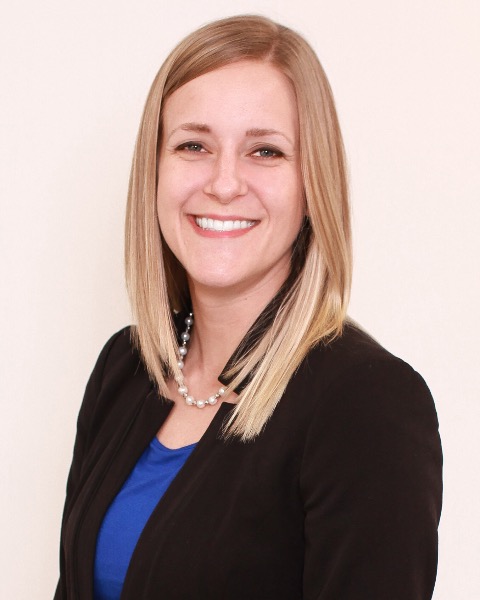Back


Introduction: Individuals with opioid use disorder (OUD) may encounter challenges when filling buprenorphine prescriptions. Pharmacies in Appalachia and the Southwestern states are more likely to refuse to dispense buprenorphine, with independent pharmacies in rural areas being more restrictive than chain pharmacies. Buprenorphine availability at the community pharmacy may vary by state. Michigan makes a good case study having counties with high drug overdose mortality, and anecdotal reports of pharmacy level barriers to buprenorphine. There is a paucity of data about Michigan pharmacist perceptions of buprenorphine use for OUD and the effect on availability of buprenorphine at community pharmacies. A statewide survey of Michigan community pharmacists aimed to identify pharmacist perceptions of buprenorphine for OUD and willingness to dispense buprenorphine and compare responses across demographics, practice settings and geographic location to identify opportunities for targeted education.
Methods: A 35-item, voluntary, de-identified electronic survey was mailed to Michigan licensed pharmacists (n=11,123) from January to March 2021 to obtain self-assessed perceptions regarding buprenorphine for OUD. Survey items assessed pharmacists’ perceptions of stigma, buprenorphine diversion and crime risk, confidence in patient and provider interactions regarding buprenorphine, buprenorphine availability, and access to local providers, training, and demographics. Response was 7% (n=775), with (n=390) respondents self-identifying as the target population of community pharmacists, completing the survey in entirety. Cross tabulations and logistic regression analyzed variables, p< 0.05
.
Results: Pharmacists were 84% white, aged 45 to 64 years, and 50.5% female. Twenty-five percent practiced in a rural area. Common practice sites were chain retail or independent pharmacy (30% each) and grocery pharmacy (18.2%). The majority (97%) had buprenorphine training from various sources, with 50% from Accredited Continuing Pharmacy Education (ACPE). Eighty percent practiced at a pharmacy that dispenses buprenorphine, with a higher proportion of rural pharmacists (90%) than urban (71%) responding yes. More pharmacists from urban areas selected “unsure” (8%) than those from rural (0%). Overall, more pharmacists at independent pharmacies (13%) than chain retail pharmacists (6%) responded “no”. Predictors of pharmacist disagreement with “would rather not dispense buprenorphine for OUD” were urban location (OR: 0.55; CI 0.34-0.91; p=0.01), independent pharmacy setting (OR: 0.53; CI 0.30-0.94; p=0.03), ACPE training (OR: 0.54; CI 0.34-0.87; p=0.01), low stigma, diversion, and risk scores (OR:0.51; C I 0.37-0.70; p=0.00), and confidence during patient and provider interactions (OR: 0.14; CI 0.10-0.19; p=0.00). Factors decreasing likelihood of pharmacist perception that buprenorphine diversion is common where they practice were urban location (OR: 0.55; 0.34 0.91 p=0.02); and low stigma, diversion, risk scores (OR: 0.46; CI 0.35 0.60 p=0.00).
Conclusion: The majority of survey pharmacists practice at a pharmacy that dispenses buprenorphine for OUD, with a larger proportion from rural pharmacies reporting buprenorphine availability. Pharmacists practicing at an independent pharmacy in an urban location were most likely to dispense buprenorphine. Urban pharmacists were likely to have lower perceptions of buprenorphine diversion compared with rural. Availability of buprenorphine at Michigan pharmacies differs from rural states. Differences in buprenorphine availability and pharmacist perceptions are opportunities for education. Limitations include one state, response bias, self-assessed competencies and small unbalanced sample sizes.
References: Haelle T: Pharmacist stigma a barrier to rural buprenorphine access. Clin Psychiatr News. 2019. https://www.mdedge.com/psychiatry/article/205251/addiction-medicine/pharmacist-stigma-barrier-rural-buprenorphine-access. Accessed September 1, 2021.
Hill LG, Loera LJ, Evoy KE, et al. Availability of buprenorphine/naloxone films and naloxone nasal spray in community pharmacies in Texas, USA. Addiction. 2020;116(6):1505-1511. doi:10.1111/add.15314
Kazerouni NJ, Irwin AN, Levander XA, et al. Pharmacy-related Buprenorphine Access Barriers: An audit of pharmacies in counties with a high opioid overdose burden. Drug and Alcohol Dependence. 2021;224:108729. doi:10.1016/j.drugalcdep.2021.108729
Trull, EM, Harless C, Trule WG, Ostrach B, Carpenter D. Rural community pharmacist willingness to dispense Suboxone® - A secret shopper investigation in South-Central Appalachia,Exploratory Research in Clinical and Social Pharmacy 2021;4:100082, doi.org/10.1016j.rcsop.2021.100082.
(17) Rural and Urban Michigan Pharmacists’ Perceptions of Buprenorphine for Opioid Use Disorder
Friday, April 1, 2022
11:30 AM – 1:00 PM ET
Location: Great Hall Foyer, Third Floor

Has Audio

Victoria Tutag Lehr, PharmD
Professor
Eugene Applebaum College of Pharmacy, Wayne State University, Michigan
Claire Nolan, PharmD
Program Manager
Michigan Center for Clinical Systems Improvement, Michigan
Presenter(s)
Non-presenting author(s)
Introduction: Individuals with opioid use disorder (OUD) may encounter challenges when filling buprenorphine prescriptions. Pharmacies in Appalachia and the Southwestern states are more likely to refuse to dispense buprenorphine, with independent pharmacies in rural areas being more restrictive than chain pharmacies. Buprenorphine availability at the community pharmacy may vary by state. Michigan makes a good case study having counties with high drug overdose mortality, and anecdotal reports of pharmacy level barriers to buprenorphine. There is a paucity of data about Michigan pharmacist perceptions of buprenorphine use for OUD and the effect on availability of buprenorphine at community pharmacies. A statewide survey of Michigan community pharmacists aimed to identify pharmacist perceptions of buprenorphine for OUD and willingness to dispense buprenorphine and compare responses across demographics, practice settings and geographic location to identify opportunities for targeted education.
Methods: A 35-item, voluntary, de-identified electronic survey was mailed to Michigan licensed pharmacists (n=11,123) from January to March 2021 to obtain self-assessed perceptions regarding buprenorphine for OUD. Survey items assessed pharmacists’ perceptions of stigma, buprenorphine diversion and crime risk, confidence in patient and provider interactions regarding buprenorphine, buprenorphine availability, and access to local providers, training, and demographics. Response was 7% (n=775), with (n=390) respondents self-identifying as the target population of community pharmacists, completing the survey in entirety. Cross tabulations and logistic regression analyzed variables, p< 0.05
.
Results: Pharmacists were 84% white, aged 45 to 64 years, and 50.5% female. Twenty-five percent practiced in a rural area. Common practice sites were chain retail or independent pharmacy (30% each) and grocery pharmacy (18.2%). The majority (97%) had buprenorphine training from various sources, with 50% from Accredited Continuing Pharmacy Education (ACPE). Eighty percent practiced at a pharmacy that dispenses buprenorphine, with a higher proportion of rural pharmacists (90%) than urban (71%) responding yes. More pharmacists from urban areas selected “unsure” (8%) than those from rural (0%). Overall, more pharmacists at independent pharmacies (13%) than chain retail pharmacists (6%) responded “no”. Predictors of pharmacist disagreement with “would rather not dispense buprenorphine for OUD” were urban location (OR: 0.55; CI 0.34-0.91; p=0.01), independent pharmacy setting (OR: 0.53; CI 0.30-0.94; p=0.03), ACPE training (OR: 0.54; CI 0.34-0.87; p=0.01), low stigma, diversion, and risk scores (OR:0.51; C I 0.37-0.70; p=0.00), and confidence during patient and provider interactions (OR: 0.14; CI 0.10-0.19; p=0.00). Factors decreasing likelihood of pharmacist perception that buprenorphine diversion is common where they practice were urban location (OR: 0.55; 0.34 0.91 p=0.02); and low stigma, diversion, risk scores (OR: 0.46; CI 0.35 0.60 p=0.00).
Conclusion: The majority of survey pharmacists practice at a pharmacy that dispenses buprenorphine for OUD, with a larger proportion from rural pharmacies reporting buprenorphine availability. Pharmacists practicing at an independent pharmacy in an urban location were most likely to dispense buprenorphine. Urban pharmacists were likely to have lower perceptions of buprenorphine diversion compared with rural. Availability of buprenorphine at Michigan pharmacies differs from rural states. Differences in buprenorphine availability and pharmacist perceptions are opportunities for education. Limitations include one state, response bias, self-assessed competencies and small unbalanced sample sizes.
References: Haelle T: Pharmacist stigma a barrier to rural buprenorphine access. Clin Psychiatr News. 2019. https://www.mdedge.com/psychiatry/article/205251/addiction-medicine/pharmacist-stigma-barrier-rural-buprenorphine-access. Accessed September 1, 2021.
Hill LG, Loera LJ, Evoy KE, et al. Availability of buprenorphine/naloxone films and naloxone nasal spray in community pharmacies in Texas, USA. Addiction. 2020;116(6):1505-1511. doi:10.1111/add.15314
Kazerouni NJ, Irwin AN, Levander XA, et al. Pharmacy-related Buprenorphine Access Barriers: An audit of pharmacies in counties with a high opioid overdose burden. Drug and Alcohol Dependence. 2021;224:108729. doi:10.1016/j.drugalcdep.2021.108729
Trull, EM, Harless C, Trule WG, Ostrach B, Carpenter D. Rural community pharmacist willingness to dispense Suboxone® - A secret shopper investigation in South-Central Appalachia,Exploratory Research in Clinical and Social Pharmacy 2021;4:100082, doi.org/10.1016j.rcsop.2021.100082.
